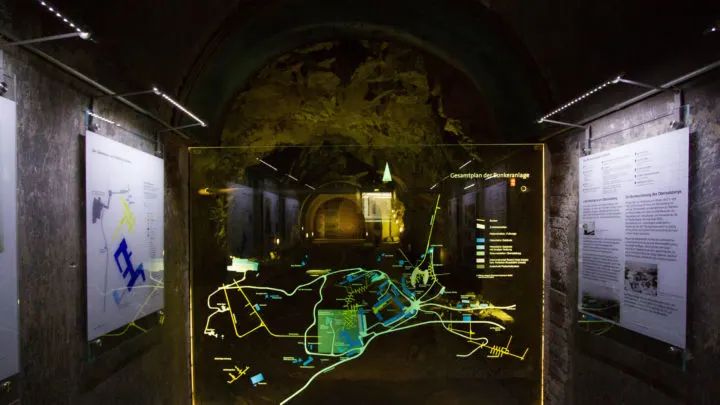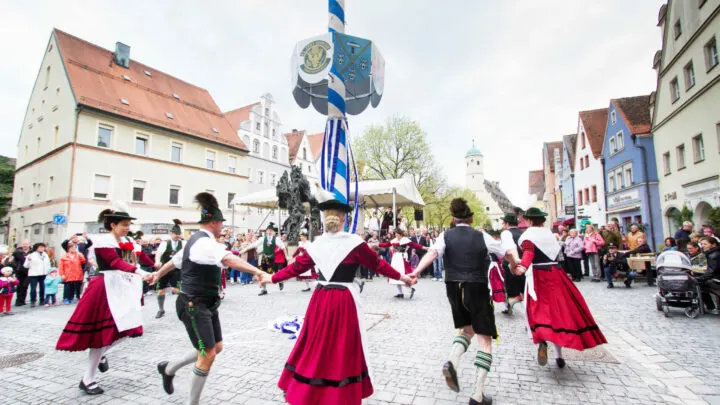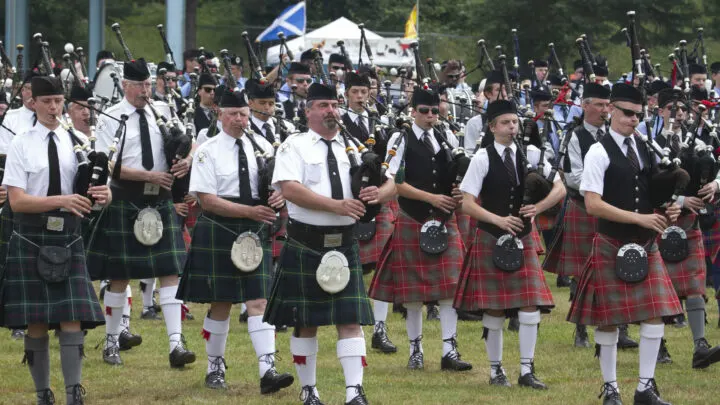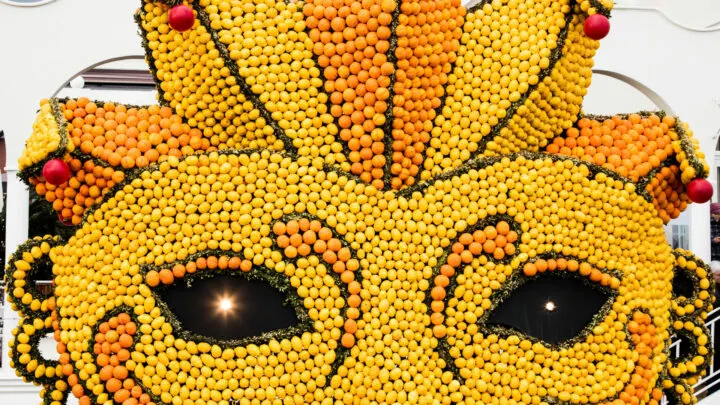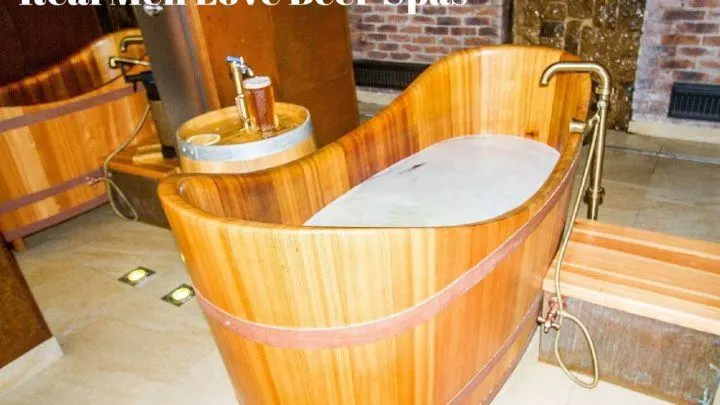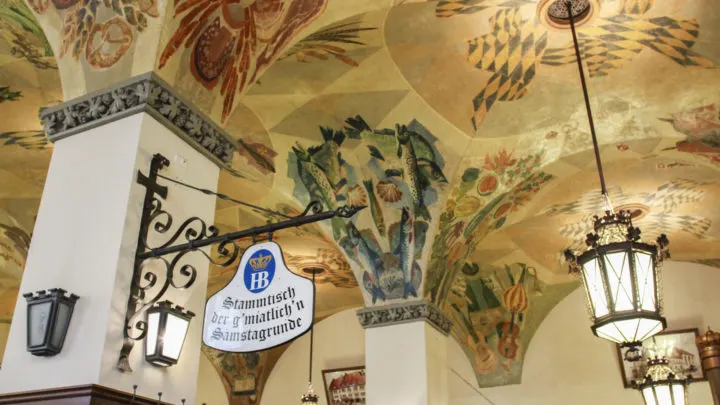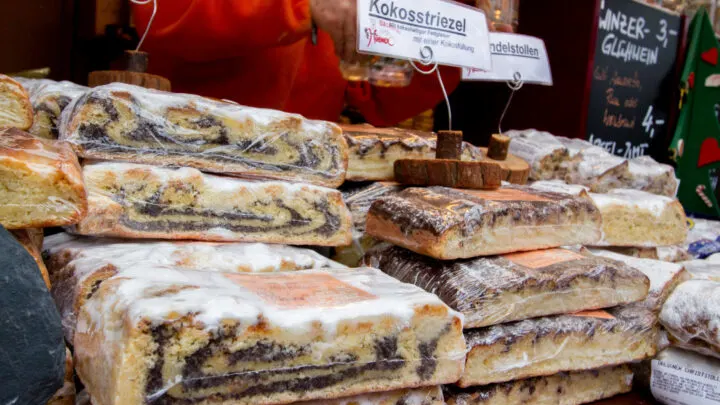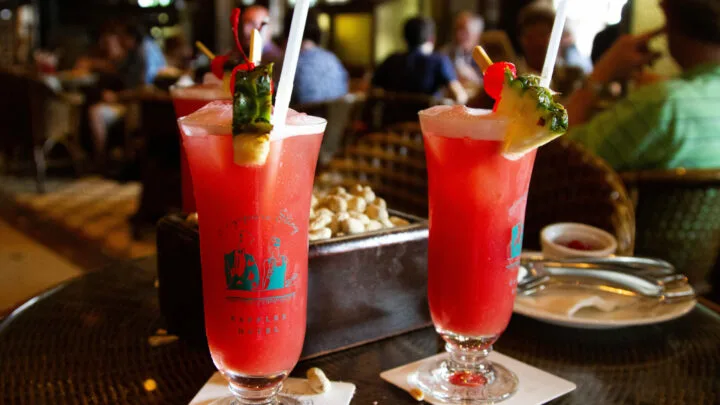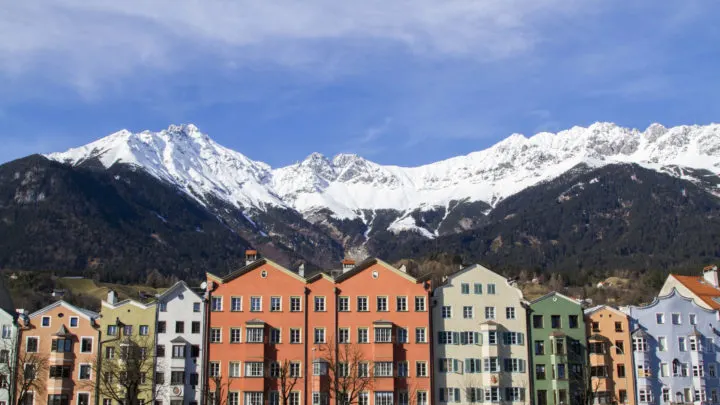Do you love wine? German white wines? If so, a German wine vineyard tour should be on your bucket list! Read along as we tell you about the epic time we had at the Singer-Fischer Vineyard in Germany.
I’ve lived in Germany off and on for a good portion of my life, and in doing so, I have fallen in love with German wine. For me, their white wines, grown all over the country, are some of the best in the world. I love a good Riesling, Gewurztraminner, Spaetlese, Auslese, Trocken (dry), or Halbtrocken (half dry), and really so many more, that I just can’t name them all.
So, when I had a chance to take a vineyard tour, I jumped on it. My brother-in-law, Chris, found a tour that would take us to the Singer-Fischer vineyard where they specialize in red, white, and sparkling wines. It’s a multigenerational family-owned and run business, and because of that, they’ve infused a key ingredient – love!
In this article:
- German White Wines
- Ingelheim – the Red Wine City
- Our Vineyard Tour Experience
- Activity Rating
- Plan Your Vineyard Tour

German White Wines
There are several very popular wine regions in Germany, and one of the best-known is the Rheingau area along the Rhine River. When you drive down around the valley, you can see vineyards on both sides of the river. The vibrant green rows of heavily-laden grapes seem to march up into and over the rolling hills in their neat, straight lines.
Both the Rhine and Mosel regions have rocky terroir and sleet soils, and the grapes thrive under the sun’s beating rays. Throughout the summer and fall, the vineyards produce beautiful German white wines.
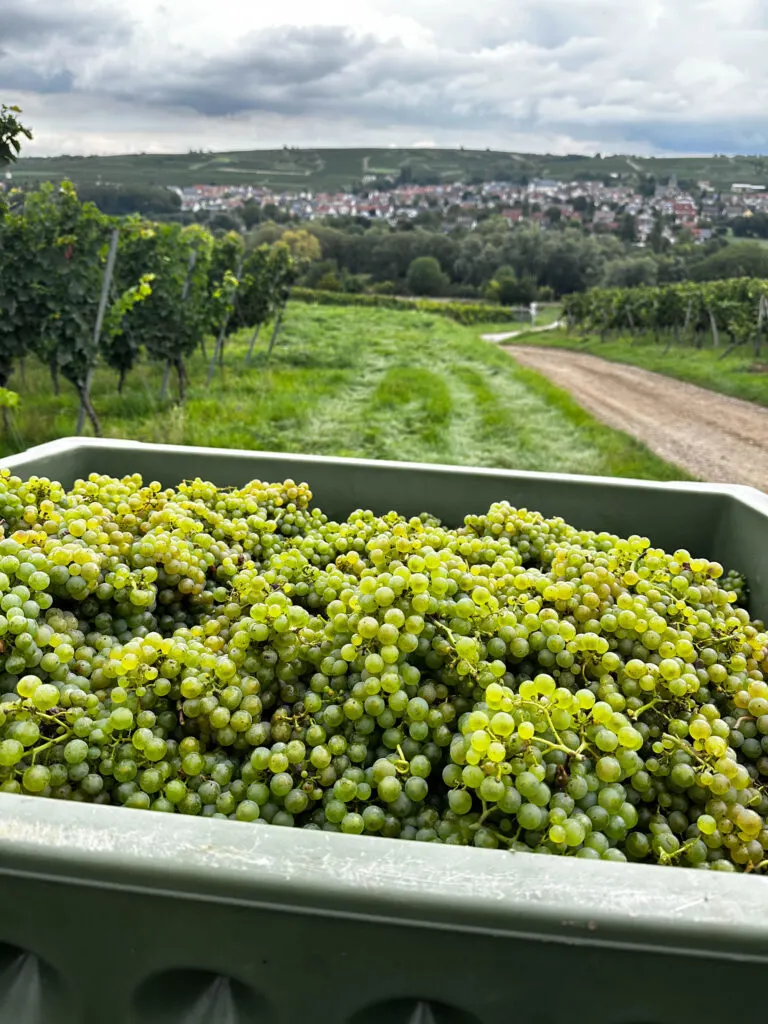
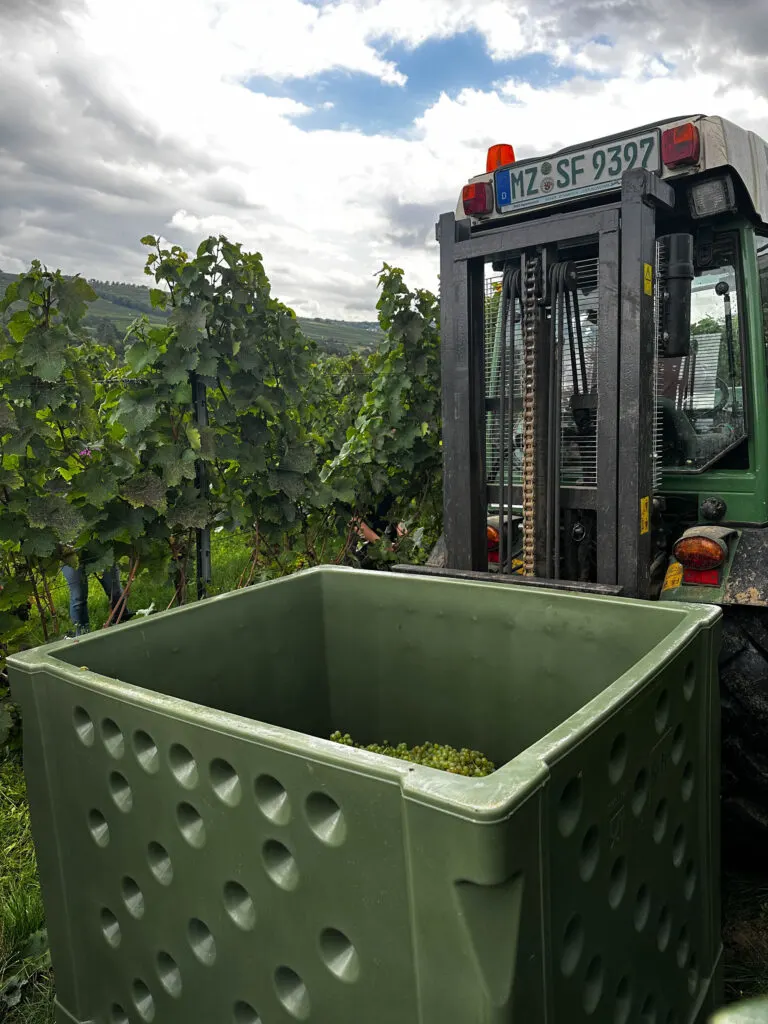
One of the best white wines we have ever had was in Franconia (also known for its Easter traditions) where we fell in love with Silvaner wines. We really enjoyed them all over the region, especially in Nuremberg and Rothenburg ob Tauber.
Franconian wines are the only type of white wine that is produced in Bavaria. However, most people would probably think of Rhineland Palatinate or Mosel wines before thinking of Bavaria. Since we were in Ingelheim, which is part of the Rhine wine area, we got to experience some of the best wines in the region.
During our visit to the Singer-Fischer family we tasted a few of their wines, most of which were Riesling and Pinot. Rieslings are famous German wines known for their citrusy flavors, clarity and sharpness. I grew up on them and still prefer them to any other white wine.
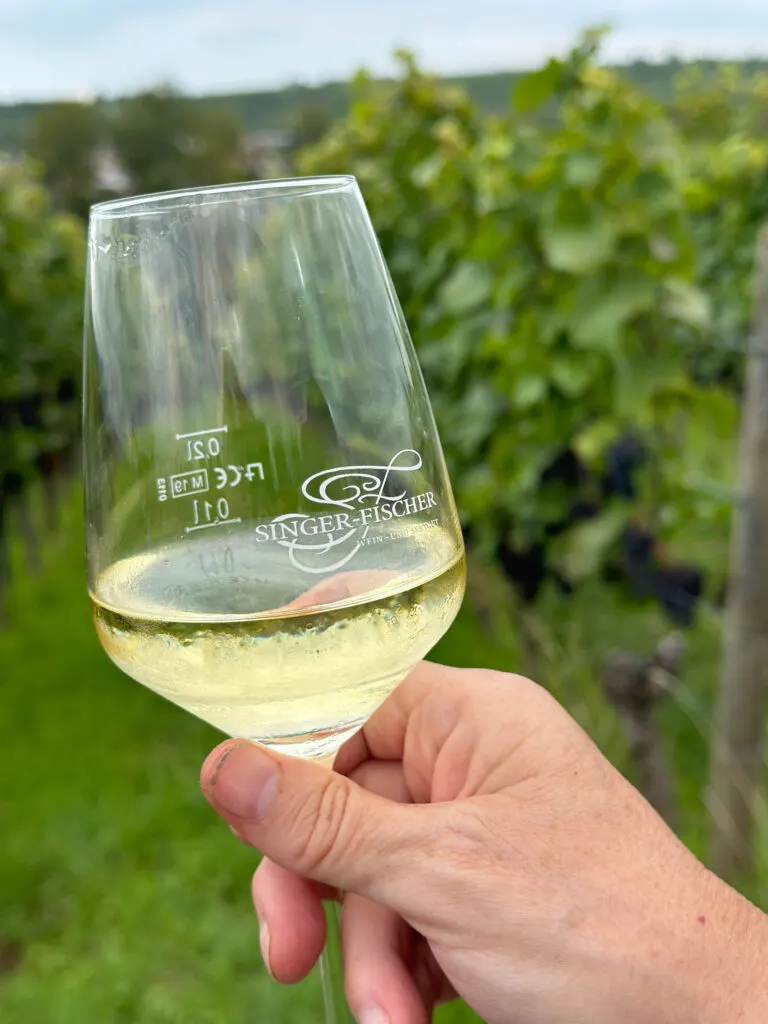
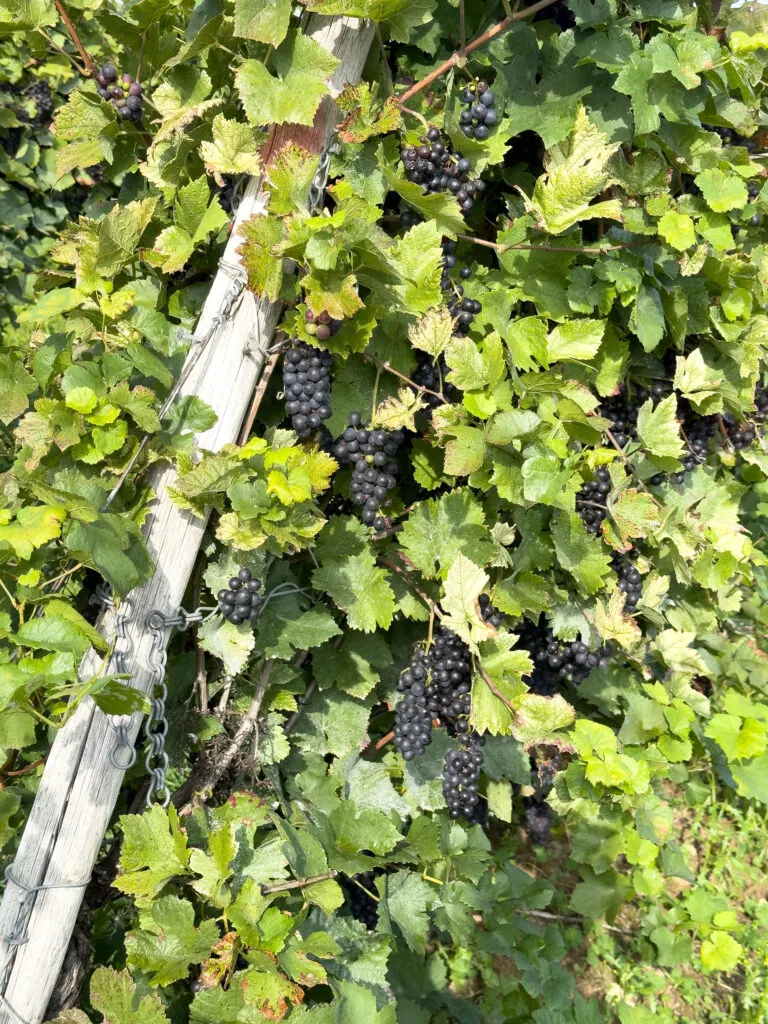
We also tried their Summer Wine, which was a blend of the Müller-Thurgau, Scheurebe and Bacchus grape varieties. It was tangy and fruity, and one of Jim’s favorites, “Perfect,” he said “for drinking after a hard day’s picking grapes off the vines!”.
My favorite was the Pinot Blanc which we had at our al fresco lunch in the vineyards. This was a fruity, floral wine that tickled my senses. I had two glasses of it, and of course, had to buy some to bring home.
When I was younger, a young 20-something, I really hadn’t developed a taste for the drier wines yet, so I relied on the sweet wines, and I still love them today. The sweeter wines come from a late harvest. Leaving the grape on the vine longer into the fall, makes them sweet.
While most of Singer-Fischer’s wines are on the drier side, they do produce a sweet Spaetlase wine. I loved it, and we also bought a couple of bottles to take home. I like to have it as a dessert wine, at the end of the meal.


Ingelheim – the Red Wine City
In general, you don’t think of red wines as being a product of Germany. French and Italian wines are much more popular for reds, but surprisingly Germany has been closing the gap, and one of the things about visiting this winery was that Ingelheim calls itself the “Red Wine City.”
Apparently, the Emperor Charlemagne brought burgundy wines to the region around 768 AD, many, many years ago, and the tradition stuck. So much so, that this winery produces a wonderful red wine as well. We didn’t pick any red wine grapes, but we did have lunch in that part of the vineyard, and I just couldn’t help but love our surroundings amongst the plump bunches of Pinot Noir grapes.
Our Vineyard Tour Experience
We began our journey by taking a wagon ride to the vineyards. Jan, Klaus’ son and the main person in charge of the winery, drove the tractor out of town and into the hills. Although it was a bumpy ride through the vineyards, the views of the rows and rows of grapevines with both purple and green grapes were breathtakingly beautiful.
How to Pick German White Wine Grapes
Upon disembarking, Lena, Klaus’ daughter who is a major part of the family business, briefed us on what to expect while walking down the rows of vines, and how to pick and cultivate the desired grapes. As they make a business out of wine production and don’t charge exorbitant prices for each bottle (about 6 to 9 Euros each), they need every grape they can get their hands on to make as many bottles as possible.
It hadn’t been the best summer for German wines due to a lot of intermittent rainy, sunny, and windy weather. These conditions aren’t necessarily good for grapes, and we had to learn what makes a good grape versus a not-so-great one.
Originally, we were going to pick red grapes, but it stormed the night before, making it more difficult to distinguish between the good and bad purple grapes. Therefore, the family decided to have us novices pick green grapes instead, since it’s easier to see blemishes and bad grapes.


When picking grapes, Lena showed us how to carefully examine each grape, checking for any discoloration or holes. She then used her shears to remove any bad grapes, whether it was an individual grape or a whole bunch that had some bruises or discoloration. It was important to remove any bad grapes so that they wouldn’t contaminate the rest of the batch.
When it comes to picking grapes, doing it by hand has its advantages. By selecting only the good grades, you can ensure quality. However, the majority of the picking is done by machine. Grape harvesting machines are expensive, however, costing about six euros per minute but are a much quicker method of picking. For our target of six crates of grapes, it took 30 people two hours to handpick. If we had used the machine, it would have taken only about 12 minutes.
Nonetheless, using the machine has its downsides as it picks all the grapes, regardless of quality, and we found a significant amount of bad ones that had to be removed. Therefore, I believe that handpicking is a good idea at this stage of the season. Of course, maybe I just was happy I got to do some of the hand-picking. I have to say, pruning the bad parts out of some of the grape bunches could get a bit tedious, but I still loved every minute of my experience.


Picking, Picking, and Pruning the Riesling Grapes
After we received instructions on what we needed to do, we separated into four rows for picking, and the family sprinkled in some expert pickers to assist us. We began picking, and continued for about two hours to the end of the row.
It was a lot of fun at first, but towards the last 15 to 20 minutes, I began to feel tired. I realized that picking may not be something I would choose to do in the future as a vocation, but for a day out, it was great to check it off of my bucket list.
In fact, I would call it a “once in a lifetime” experience. We’ve had a few of those during our travels. What a “once in a lifetime experience” means to us is something we did, checked it off our list, found it memorable, and a bit fun, but don’t want to do it day in and day out, or quite frankly ever again. Picking grapes during the harvest definitely falls into this category.
We picked and picked. We picked and pruned, and then we picked some more. One of the fun parts of the picking process is when Jan would call out “buckets!” This meant that it was time to empty our pails into the larger crates.
During the couple of hours, I probably picked five buckets of grapes. I think both Chris and Jim had me beat, though, and most likely picked seven or eight each. Oh well.
The six crates were then loaded up onto the tractor to be taken back to the winery for processing. Meanwhile, it was time for lunch.
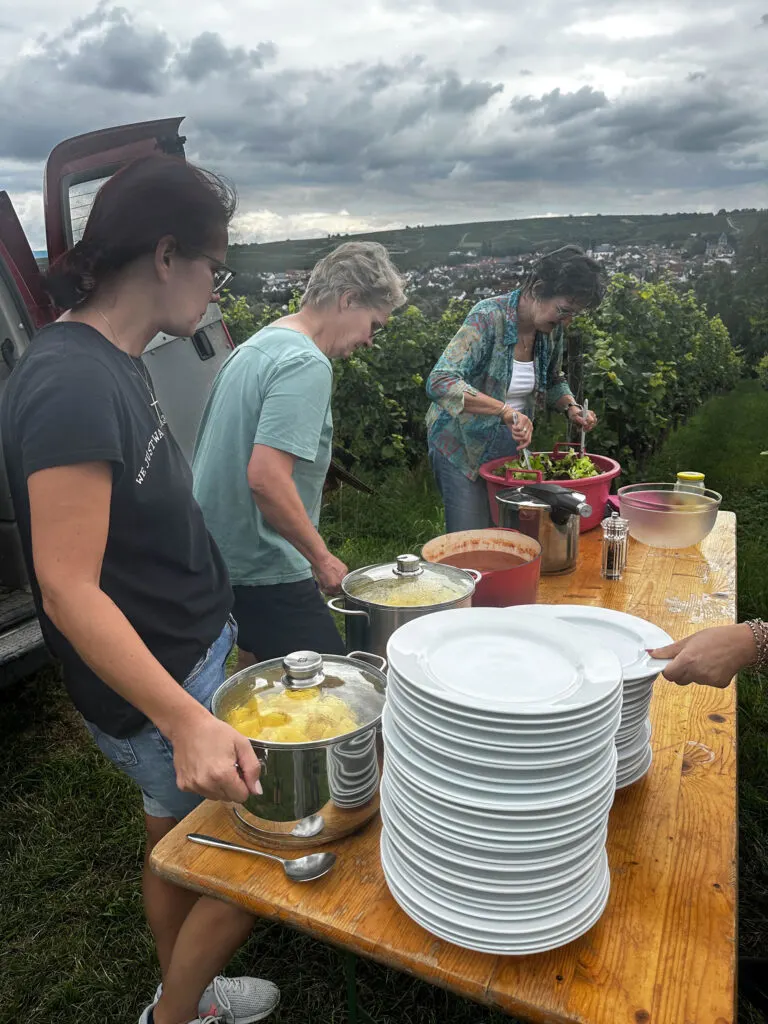
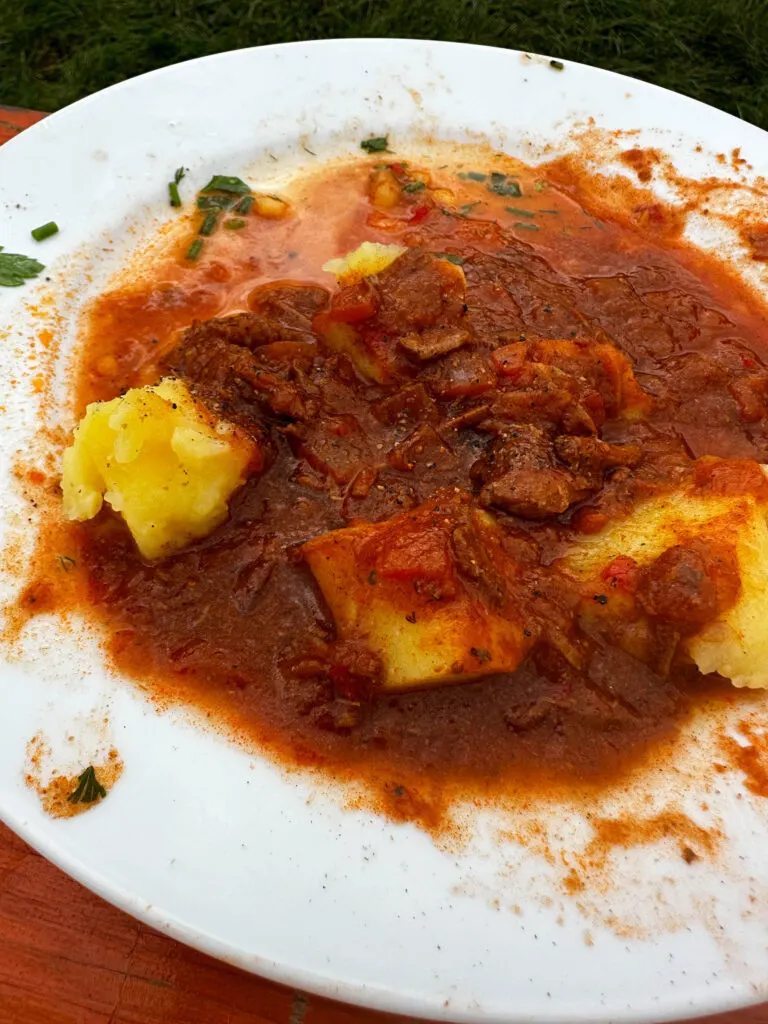
Lunch in the Vineyard
We were then directed to walk up to another area of the vineyard where some tables had been set up for lunch. It turns out that during the picking season, when grape pickers are hired, lunch is served to them as part of the deal.
This tradition has been going on for ages, where pickers not only get paid for their picking hours but also get a free lunch. According to one of the experienced pickers with us, a free lunch typically consists of something easy like a big one-pot meal, such as soup, some bread, and something to drink.

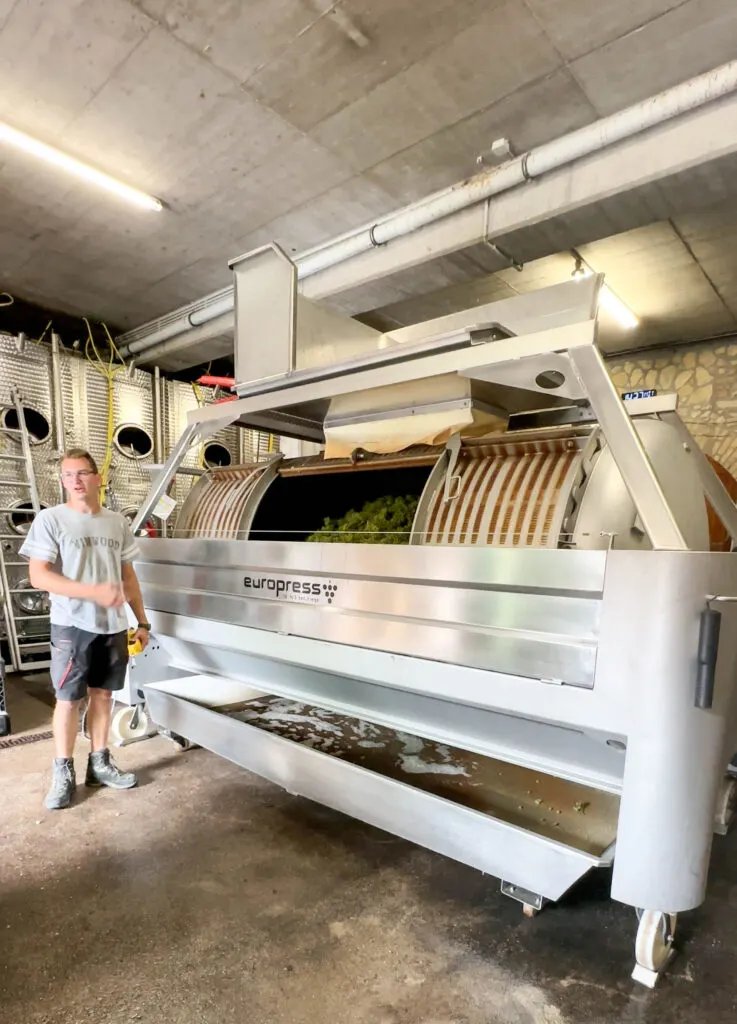
We were served a traditional goulash dish over boiled potatoes, accompanied by a salad, followed by a red wine cake for dessert. The lunch was quite filling, which is expected as pickers typically spend the entire day picking, not just a measly two hours so they want them to have lots of energy.
After finishing our lunch, we got back on the tractor and drove down the hill to the Singer-Fischer winery. We watched as they unloaded the six crates of grapes that we had picked over the previous two hours.

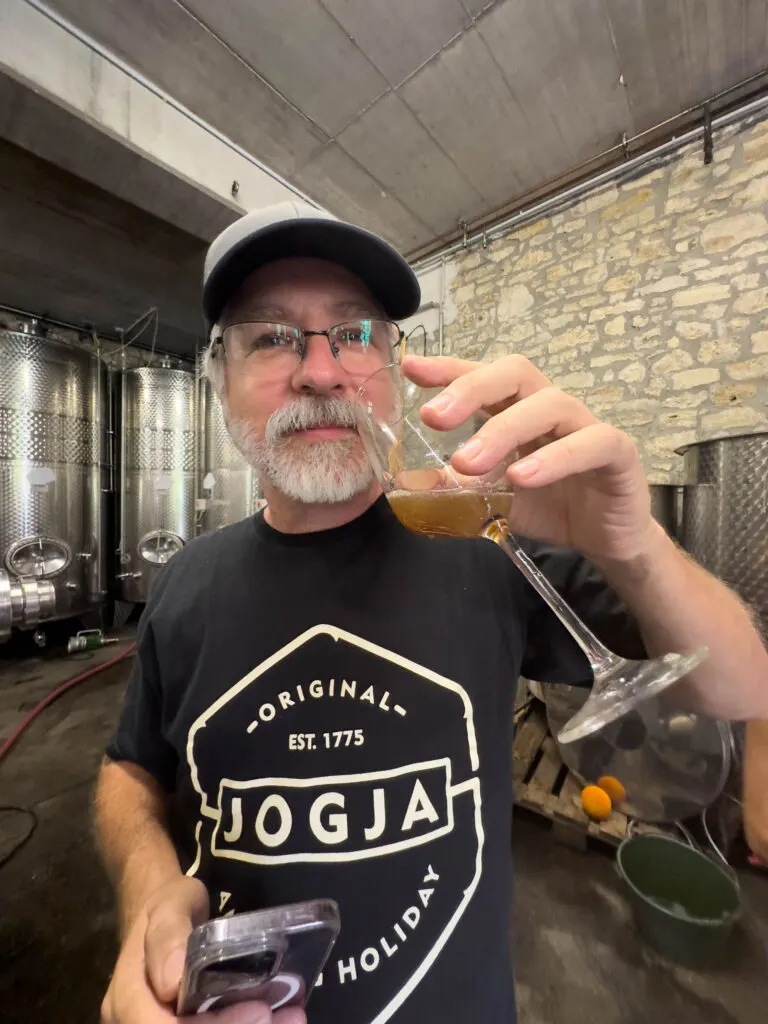
Pressing the Wine Grapes
They put the grapes into the wine press, which looked like a huge barrel. The press turned, and I’m not sure how it worked internally, but we could see the grape juice gushing underneath into a large metal pool.
Glasses were handed out, and we were able to taste the juice (or “saft”) before it was guided into a tank to start the fermentation process. The fresh grape juice didn’t taste like any juice I’ve ever had before, but boy was it good.


The next thing we did was head over to the main part of the shop where they sell all their wines. The Singer-Fischers make red, white, and sparking wines along with providing their wooden barrels to some Scottish whiskey makers, so they sell whiskey as well. Of course, we spent a lot of time tasting each of the varieties, trying to decide which ones to buy and take home. It was a fun way to end the day.
This full day of grape-picking, pressing, tasting, and having lunch in the middle of a vineyard was tons of fun. One of the things I liked the most was getting to know the other (read: “real”) pickers, and the Singer-Fischer family.
We talked about their lives as vineyard owners, growing up in a vineyard, and all kinds of stuff in between. It really makes you think about everything that goes into just one bottle of wine.
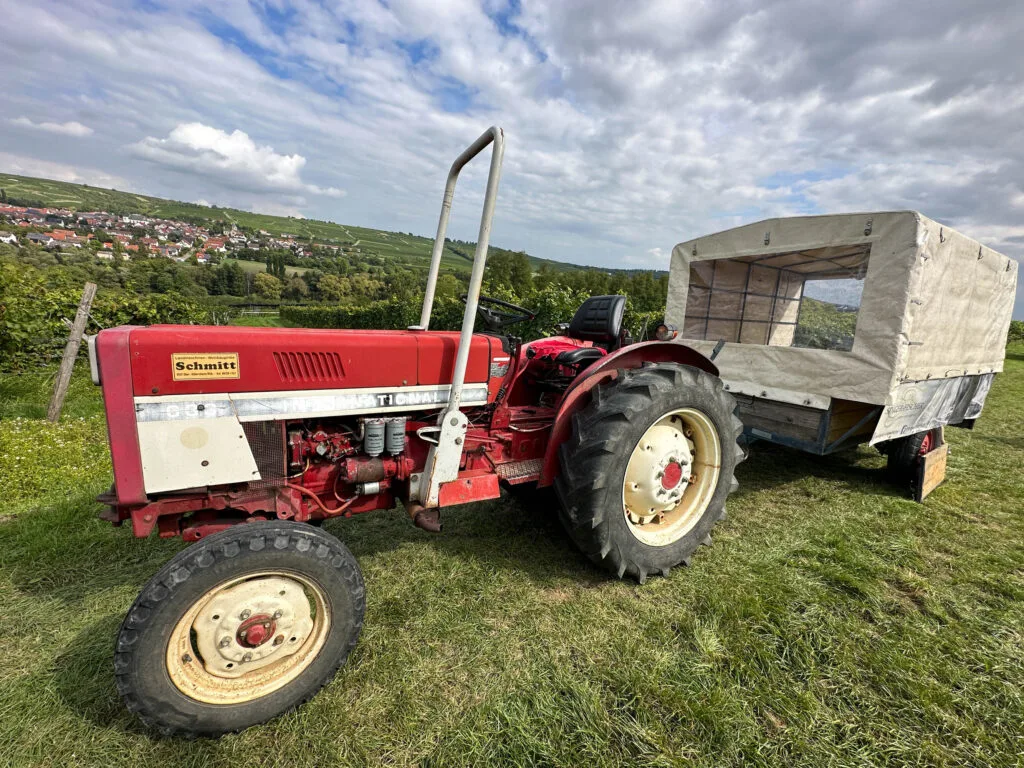
Activity Rating – A Day in the Ingelheim Vineyards

If you haven’t guessed, we absolutely loved everything about this tour. The Singer-Fischer family was welcoming, and educated us on all things wine-related.
Our day picking the grapes, having lunch in the vineyard, and then pressing and trying the wine was nothing short of magical. I would do it again and again.
In saying that, I wouldn’t want to do if for a job. Picking those grapes, like any repetitive job would definitely get arduous. I was more than finished with this part of the day when our four rows had been picked clean.
However, I would eat in a vineyard everyday if I could. It was a beautiful day, the sun was shining, it was the perfect temperature, and the food was hearty, made so much more tasty accompanied by copious amounts of wine.
How to Plan Your Own Vineyard Tour
It’s not the easiest thing to find a tour that will let you get into the wine fields to pick the grapes, but there are quite a few great wine tours that you can take.
To begin with, the Singer-Fischer family has trailer tours of the vineyards where they stop at each grape variety, and let you taste the wine that was produced. What fun! All you have to do is send them an email to set it up.
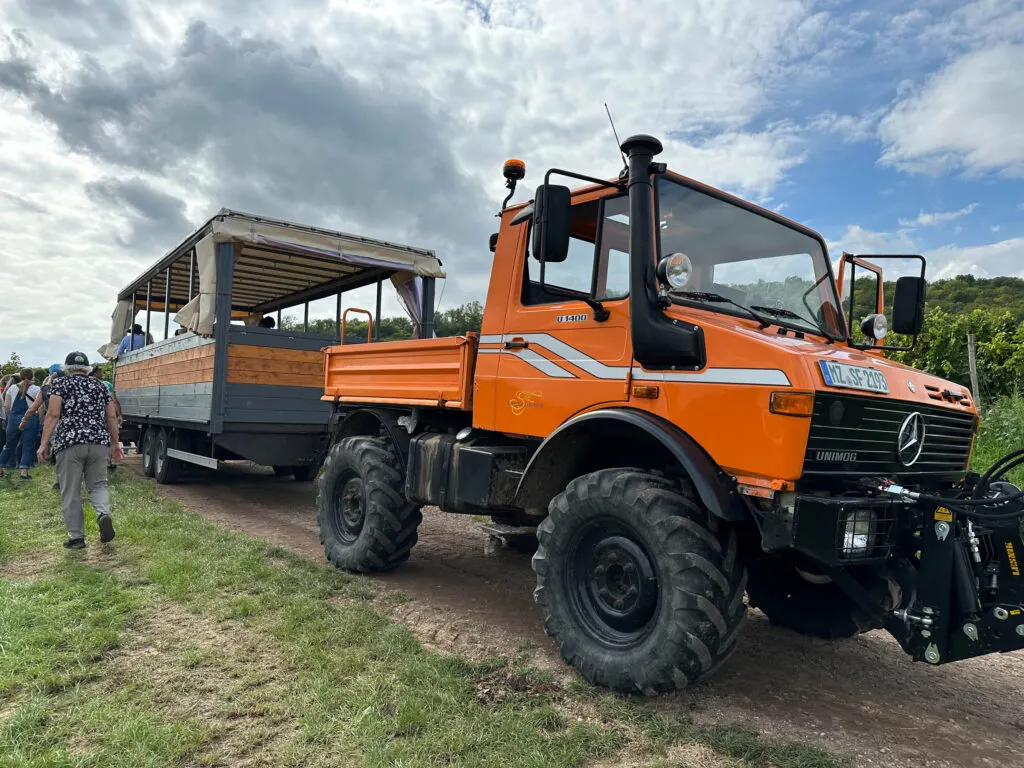
Conclusion
I had so much fun during the tour we took. We got to combine grape-picking, having lunch at a vineyard and tasting various wines throughout the day. I came back home a bit tired and sore, but extremely happy and content after a fulfilling day.
Author Bio: Corinne Vail is a travel photographer, food lover, and a perpetual traveler who has been travel writing for over 14 years. For many years she lived overseas in Germany, Japan, Turkey, South Korea, and the Netherlands teaching the children of the US. military. She’s visited over 90 countries, and she’s not stopping anytime soon.

